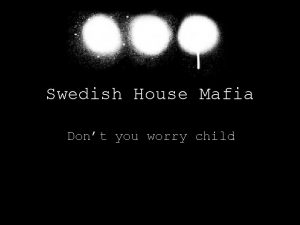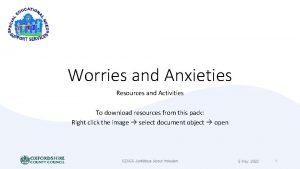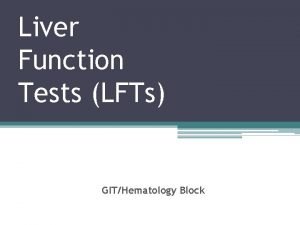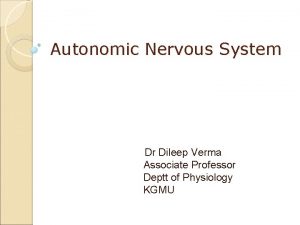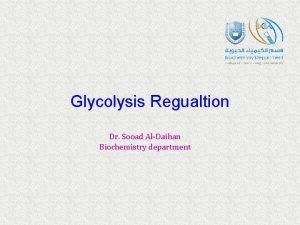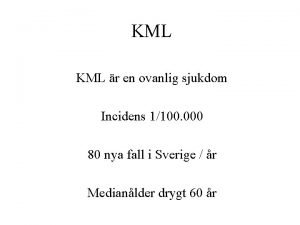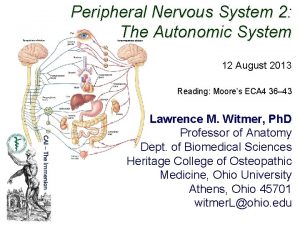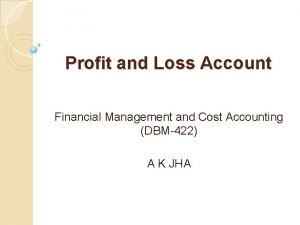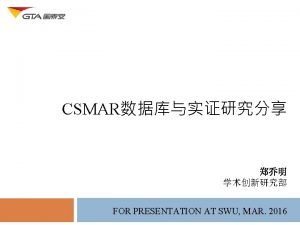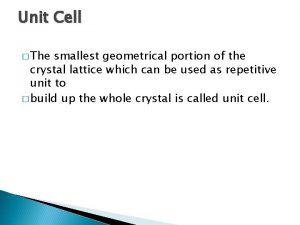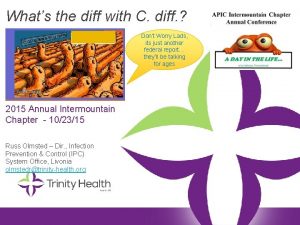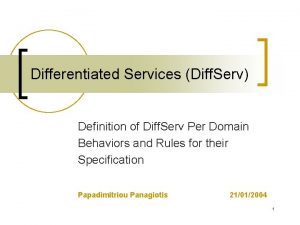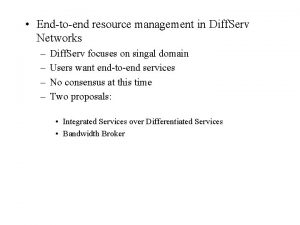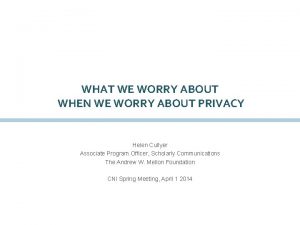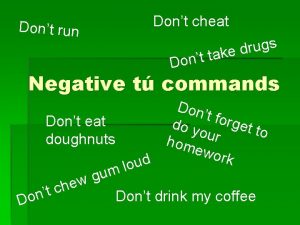Whats the diff with C diff Dont Worry













































- Slides: 45

What’s the diff with C. diff. ? Don’t Worry Lads, its just another federal report… they’ll be talking for ages 2015 Annual Intermountain Chapter - 10/23/15 Russ Olmsted – Dir. , Infection Prevention & Control (IPC) System Office, Livonia olmstedr@trinity-health. org © 2014 Trinity Health. All Rights Reserved.

Objectives & Disclosures 1. Describe the epidemiology of C. difficile infection (CDI) in the U. S. 2. Understand the pathogenesis of CDI. 3. List at least one strategy to prevent CDI 4. Describe new contributions to the scientific literature on CDI as well as select highlights from ID Week 2015. . R. Olmsted is a member of a Speakers’ Bureau sponsored by Ethicon, Inc. & consultant to Premier Inc. ’s Safety Institute © 2014 Health. Trinity All Health - Livonia, MI © 2014 Trinity Rights Reserved. 22

Discharge rate for Clostridium difficile infection from US short-stay hospitals by age Fernanda C. Lessa et al. Clin Infect Dis. 2012; 55: S 65 -S 70

Morbidity & Mortality Associated with C. difficile infection (CDI) – business case for prevention Lessa FC, et al. N Engl J Med 2015; 372: 825 -34. © 2014 Trinity Health. All Rights Reserved. 4

Ongoing Microbial Challenges: C. difficile infection, 2011, U. S. Estimated no. of deaths = 29, 300 Lessa FC et al. N Engl J Med 2015; 372: 825 -834. © 2014 Trinity Health. All Rights Reserved. 5

“Antibiotic Associated Pseudomembranous Colitis Due to Toxin-Producing Bacteria” Bartlett and co-workers 1 demonstrated cytotoxicity in tissue culture and enterocolitis in hamsters from stool isolates from patients with pseudomembranous colitis • Isolate was C. difficile Bacillus difficilis (now confirmed as C. difficile) was cultured from healthy neonates (with difficulty, hence the name) in 19352 1. Bartlett JG, et al. NEJM. 1978; 298: 531 -534. Trinity Health. All Rights Reserved. 2. Hall JC and O’Toole E. Am J Dis Child. © 2014 1935; 49: 390 -402. 6

Risk Factors for Infection q q q q Hospitalization or long-term care facility Antibiotics (some more than others) Other medication exposure: chemotherapy, immunosuppressants, proton pump inhibitors Increasing age (>65, >>80) Co-morbidities Surgery Community-associated cases • Peri-partum • Close contact of CDI (C. difficile infection) case • Food © 2014 Trinity Health. All Rights Reserved. 7

Outcomes of CDI q q q Increases length of stay by 2. 8 - 5. 5 days. Attributable costs of inpatient CDI in 2008 dollars = $3, 006– $15, 397 per episode. Patients with CDI were almost 2 x as likely to be discharged to a long-term care facility Attributable mortality = 5%– 10% Colonization of healthy non-hospitalized adults is uncommon (ie, rate <5%), however among hospitalized patients and especially nursing home residents range= 25 - 55% © 2014 Trinity Health. All Rights Reserved. 8

Collateral Consequences of CDI in Era of Value-Based Purchasing; Readmission Risks Am J Infect Control 2015; 43: 318 -22 © 2014 Trinity Health. All Rights Reserved. 9

Clostridium difficile • Anaerobic, spore-forming Gram positive bacillus • Diseases: pseudomembranous colitis, toxic megacolon, sepsis, and death • Fecal-oral transmission through contaminated environment and hands of healthcare personnel • Antimicrobial exposure is major risk factor for disease Healthy colon Pseudomembranous colitis

Clostridium difficile: A Survivor Vegetative Spores Survival time on environmental surfaces 15 min – 3 hrs n Found in the Lower GI tract n Susceptible to stomach acid n Susceptible to antibacterial soaps, alcohol hand rub and disinfectants n n Can survive for months or years on surfaces n. Form after exposure to the environment Found in the lower GI tract and the environment n Resistant to stomach acid n n Not susceptible to antibacterial soaps, alcohol hand rub and many disinfectants except dilute bleach or high level disinfectants.

Pathogenesis of Clostridium difficle Spores and vegetative Cells are ingested Most vegetative cells are killed in the stomach, but spores can survive the acid environment Stomach Small Bowel Spores Vegetative cells Spores germinate in the small bowel with exposure to bile acids

Pathogenesis of C. difficile Infection (CDI) Ingestion Germination Proliferation Toxin Production Sunenshine RH, Mc. Donald LC. Cleve Clin J Med. 2006; 73: 1987 -1997; with permission.

Epithelial Cell Destruction Vegetative cells produce Toxin A & B Increased Toxin causes self destruction of the epithelial cells The result Clostridium difficile infection: watery diarrhea, colitis and/or pseudomembranes

Fig 1. Developmental life cycle of Clostridium difficile during infection. Shen A (2015) A Gut Odyssey: The Impact of the Microbiota on Clostridium difficile Spore Formation and Germination. PLo. S Pathog 11(10): e 1005157. doi: 10. 1371/journal. ppat. 1005157 http: //127. 0. 0. 1: 8081/plospathogens/article? id=info: doi/10. 1371/journal. ppat. 1005157 © 2014 Trinity Health. All Rights Reserved. 15

Prerequisites for CDI Cefa getem all Antimicrobial therapy Disturbed colonic microflora Acquisition of toxigenic C. difficile Enterotoxin A & cytotoxin B production • Advanced age • Underlying illness CDI • CDI due to recent (re)acquisition of C. difficile • Incubation period unknown • <7 days to several weeks? • Antimicrobial exposure may or may not precede acquisition • The two appear to be in proximity

Increased Toxin B Production In Vitro In vitro production of toxins A and B by C. difficile isolates. Median concentration and IQRs are shown. C. difficile strains included 25 toxinotype 0 and 15 NAP 1/027 strains (toxinotype III) from various locations. IQR=interquartile range. Adapted from Warny M, et al. Lancet. 2005; 366: 1079 -1084; with permission.

States with BI/NAP 1/027 Strain of C. difficile (N=38), November, 2007 DC HI AK PR

Laboratory Diagnosis of CDI APIC Implementation Guide: Guide to Preventing CDI, 2013 © 2014 Trinity Health. All Rights Reserved. 19

CDC’s Vital Signs Report 03/06/2012 Patient: George

Transmission Dynamics Model CDI Donskey C. CID 2010: 50 (1 June)

Highlights from SHEA CDI Compendium, 2014 Limit testing to those with symptoms of CDI – do not perform repeat test for cure • Prompt identification of suspect case - consider lab-base alert for + • Avoid use of electronic thermometers for those with CDI – dedicated equipment if possible • Contact Precautions; ideally in private rooms • Don gown and gloves upon entry to the patient’s • room • Hand hygiene based on CDC or WHO guidelines • Ensure cleaning and disinfection of equipment and the environment • Sodium hypochlorite (household bleach) diluted 1 : 10 with water or an EPA registered sporicidal product in an outbreak or high rates • Surveillance, education – providers and patients • Special approaches: risk assessment then… • Data are currently too limited to draw any conclusions as to whether or when these devices should be a component of a CDI prevention program. In addition, excellent results can be achieved with manual cleaning with a sporicidal disinfectant • © 2014 Health. Trinity All Health - Livonia, MI © 2014 Trinity Rights Reserved. 22 22

Prevention Strategies • Prevent the spread Ø Ø Antibiotic stewardship (prudent use) Use of contact precautions Environmental cleaning/disinfection Educate: HCWs, patients, family and visitors • Prevent cross transmission between patients via the hands of HCW’s Ø Put on gloves – just before or soon after entering patient’s room Ø Emphasize Use of hand hygiene

Targeted antibiotic consumption and nosocomial C. difficile disease Tertiary care hospital; Quebec, 2003 -2006 Valiquette, et al. Clin Infect Dis 2007; 45: S 112.

Impact of Antimicrobial Stewardship Program (ASP) on HAI Outcomes; quarterly Rate of isolates per 10, 000 patient days * C. difficile* VRE MRSA* MSSA* ESBL Pseudomonas Acinetobacter Candida* Baseline 8 Quarters mean Post Intervention mean 17 Quarters 9. 00 13. 63 64. 91 35. 61 16. 41 27. 42 6. 61 22. 87 6. 19 7. 19 52. 31 46. 99 13. 29 31. 18 5. 82 18. 45 Difference in Isolates -2. 81 -6. 11 -12. 60 11. 38 -3. 12 3. 76 -0. 79 -4. 42 Comparison of Means p-value 0. 033 0. 0004 0. 007 0. 005 0. 540 0. 204 0. 518 0. 036 The changes in isolate values are reflected as either a reduction (negative sign) or increase number. Using Student T-test comparison of the means before and after intervention at p<0. 05 *Statistically significant rate reduction per quarter of pathogen isolates per 10000 patient days. Madison G, Kleina L, Turco T, Hunter J, Hallur R. ; ASP Team, Mercy Philadelphia Hospital, 10/20/15

ASP Program Impact: Purchases of Targeted Drugs by Quarter Overall reduction of 74% in targeted drugs purchased. Individual antibiotic percent reduction is as follows: carbapenems (59%), linezolid (85%), piperacillin/tazobactam (77%), vancomycin (54%).

SPECIAL CHALLENGES IN INFECTION CONTROL; CMS state operations manual, rev. 122, 9/26/14 Multidrug-resistant organisms (MDROs) Ambulatory Care Communicable disease outbreaks Bioterrorism Antimicrobial stewardship – new in 2015 © 2014 Health. Trinity All Health - Livonia, MI © 2014 Trinity Rights Reserved. 27 27

ASP Resource http: //www. cdc. gov/getsmart/healthcare/pdfs/checklist. pdf © 2014 Trinity Health. All Rights Reserved. 28

Reality Check; Back to Basics & Human Factors Full compliance with Contact Precautions (CP) for CDI was low at 2 different hospitals Adherence with CP for CDI is a complex, timeconsuming process Need human factors engineering approach to improve Yanke E, et al. Am J Infect Control 2015; 43: 241 -7 © 2014 Trinity Health. All Rights Reserved. 29

When Can Isolation Be Discontinued? Duration of illness; After resolution of symptoms, patients with CDI can continue to shed C. difficile in stool and contaminate the environment. Use for duration of hospital stay = special approach Donskey C. CID 2010: 50 (1 June) & SHEA CDI Compendium, 2014

Urban Legend? C diff and Hygiene Soap Or Alcohol Hand Rub? What is the most important action to prevent contamination of hands with spores? Wear gloves before entry to the room and remove prior to exiting the room. It is difficult to wash off spores. Is soap and water required for hand hygiene in a C diff room? If hands or gloves are visibly soiled or there is an outbreak. Does alcohol hand rub increase the rate of Clostridium difficile in the hospital? Several studies find that alcohol hand rub does not increase the rate. What happens if there is an outbreak or a high incidence of C diff on a unit? Infection Prevention & control will notify the unit if changes in hand hygiene method are needed. SHEA CDI & Hand Hygiene Compendium, 2014

Renewed Respect for Role of the Environment: Prior Room Occupant = Risk of Acquisition Growing evidence on increased risk of acquisition of specific pathogens, C. difficile, MRSA, and VRE , when admitted to room where prior occupant had one of these or if in multi-occupancy room • Huang SS (2006)1 • Drees M (2008)2 • Zhou Q (2008)3 • Moore C (2008)4 • Hamel M (2010)5 • Shaughnessy et al. ICHE 2011; 32: 201 1. Huang SS, et al. Arch Intern Med. 2006; 166(18): 1945 -1951. 2. Drees M, et al. Clin Infect Dis. 2008; 46(5): 678 -685. 3. Zhou Q, et al. Infect Control Hosp Epidemiol. 2008; 29(5): 398 -403. 4. Moore C, et al. Infect Control Hosp Epidemiol. 2008; 29(7): 600 -606. 5. Hamel M, et al. Am J Infect Control. 2010; 38(3): 173 -181. © 2014 Trinity Health. All Rights Reserved. 32

The Environment Of Care § When possible, use dedicated patient-care equipment (e. g. , blood pressure cuffs) or § If reusable equipment is unavoidable, clean and disinfect equipment before use on another patient § Focus on frequently touched surfaces (e. g. , bed rails, over bed table, bedside commode, bathrooms surfaces) and equipment in the immediate vicinity of the patient

What Do Healthcare Personnel Touch with High FREQUENCY? ICU Setting (N=28) Huslage K, Rutala WA, Sickbert-Bennett E, Weber DJ. ICHE 2010

TERMINAL ROOM CLEANING: DEMONSTRATION OF IMPROVED CLEANING l l Evaluated cleaning before and after an intervention to improve cleaning 36 US acute care hospitals Assessed cleaning using a fluorescent dye Interventions n n Increased education of environmental service workers Feedback to environmental service workers †Regularly change “dotted” items to prevent targeting Carling PC, et al. ICHE 2008; 29: 1035 -41 objects

Automated, No-Touch Disinfection Vaporized Hydrogen Peroxide Ultraviolet Germicidal Irradiation (UVGI)

Comparison of H 2 O 2 vs UVGI NTD = No touch disinfection Some new evidence; J Hosp Infect 2013; 83: 1 -13 select devices in 2014 © 2014 Trinity Health - Livonia, MI 37

Recommended Framework for Assessing Need and Value of No Touch Disinfection (NTD) 1. 2. 3. 4. 5. Review data on frequency of healthcare associated infections (HAIs) – does this identify opportunities to improve cleaning/disinfection of the environment? Engage key stakeholders; Environmental Services and Infection Prevention & Control (IPC) leaders to review and assess need + value Apply peer-reviewed, scientific evidence to identify need Is there sufficient infrastructure to operate NTD devices and will this be sustained? What is level of adherence by colleagues and clinicians with other core prevention strategies, e. g. hand hygiene, isolation precautions, antibiotic stewardship, etc. ? © 2014 Health. Trinity All Health - Livonia, MI © 2014 Trinity Rights Reserved. 38 38

No Touch Disinfection? Key questions APIC. Guide to Preventing CDI, 2013

Fecal microbiota transplants (FMT) FMT has demonstrated extraordinary clinical resolution, C. difficile infection cure rates of over 90%, and low recurrence [Borody T, et al. Expert Rev Gastroenterol Hepatol. 2015 Sep 28: 1 -13] One option; Open Biome http: //www. openbiome. org/ © 2014 Health. Trinity All Health - Livonia, MI © 2014 Trinity Rights Reserved. 40 40

Highlights from ID Week, 2015 UVGI was deployed for 21. 1% (542/2569) of all patient discharges on the 3 study units Rates of CDI declined 25% on the study units and increased 16% on non-study units during the intervention vs. baseline period. © 2014 Trinity Health. All Rights Reserved. 41

Highlights from ID Week, 2015 28 months in 9 study hospitals from 4/2012 to 7/2014 quaternary ammonium (reference group A) compared to 3 enhanced cleaning strategies: § quaternary ammonium + UV-C (B), § bleach (C), and § bleach + UV-C (D). bleach was used for daily and terminal disinfection of all known C. difficile rooms, regardless of study arm. Target pathogens = MRSA, VRE, C. difficile, or MDR Acinetobacter © 2014 Trinity Health. All Rights Reserved. 42

Highlights from ID Week, 2015 BETR Study, continued all target MDROs was 37% lower in Group B (p=0. 03) and 32% lower in Group D (p=0. 01) No significant impact on incidence of CDI with UVGI over dilute bleach alone. © 2014 Trinity Health. All Rights Reserved. 43

Risk Based Planning Risk Assessment Infection risk assessment IC. 03. 01 Evaluation IC. 01. 03. 01 Risks Goal Reduce or eliminate infection Implementation Based on guidelines and organizationspecific risk IC. 02. 01 Implementation Evaluation IC. 01. 04. 01 Goals Rates reduced? Best practices followed? Implementation complete? D. Rumovitz – St. Mary Medical Ctr, Langhorne, PA; Spring 2014 ART Conference

Thank You…. Discussion/Questions © 2014 Trinity Health. All Rights Reserved. 45 45
 Dont worry be happy notes
Dont worry be happy notes Dont worry be ready
Dont worry be ready Diff in diff regression
Diff in diff regression Dont ask dont tell political cartoon
Dont ask dont tell political cartoon Don't laugh at me allen shamblin
Don't laugh at me allen shamblin Where was don't you worry child filmed
Where was don't you worry child filmed Worry rhyme
Worry rhyme Liver function test results
Liver function test results The very hungry worry monster activities
The very hungry worry monster activities Worry defined
Worry defined Worry less enjoy more
Worry less enjoy more Fever in toddler
Fever in toddler Sermon on worry
Sermon on worry Which of these business situations would worry you most
Which of these business situations would worry you most Explore more worry less
Explore more worry less Constituency tests syntax
Constituency tests syntax Worry rhyme
Worry rhyme Lft normal range
Lft normal range Big bigger biggest example
Big bigger biggest example Difference between sympathetic and parasympathetic
Difference between sympathetic and parasympathetic Prokaryotic and eukaryotic difference
Prokaryotic and eukaryotic difference Sum and diff identities
Sum and diff identities Splunk analytics example
Splunk analytics example Average rate of change calculus
Average rate of change calculus Proportion and ratio difference
Proportion and ratio difference Diff between workgroup and domain
Diff between workgroup and domain Prevascular femoral hernia
Prevascular femoral hernia Does oxivir kill c diff
Does oxivir kill c diff Optical fibre
Optical fibre What is the difference between ad and bc?
What is the difference between ad and bc? Definition of oral communication
Definition of oral communication Diff between prismatic and surveyor compass
Diff between prismatic and surveyor compass Biochemistry
Biochemistry Vänsterförskjuten diff
Vänsterförskjuten diff Diff between sympathetic and parasympathetic
Diff between sympathetic and parasympathetic Diff
Diff Parietal mesoderm
Parietal mesoderm Servicios diferenciados
Servicios diferenciados Diff of sec^2x
Diff of sec^2x Trading and profit and loss account format
Trading and profit and loss account format Diff between primary and secondary battery
Diff between primary and secondary battery Fibers
Fibers Avg diff
Avg diff Data structures unit 1
Data structures unit 1 Write difference between frenkel and schottky defect
Write difference between frenkel and schottky defect Difference between counselling and advice
Difference between counselling and advice





